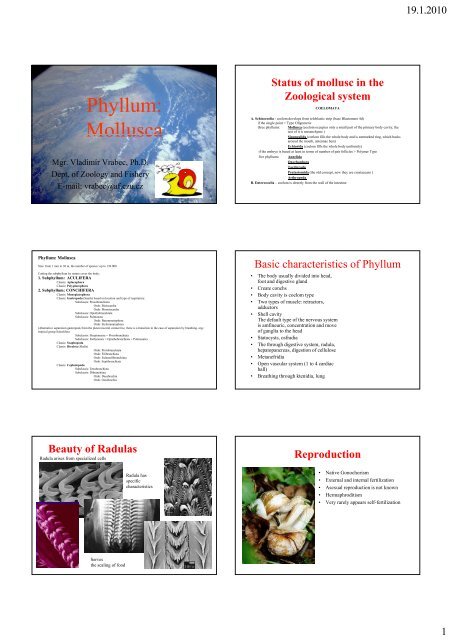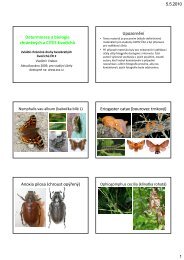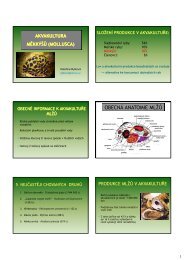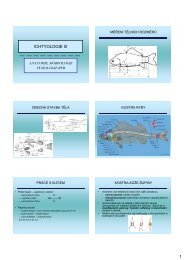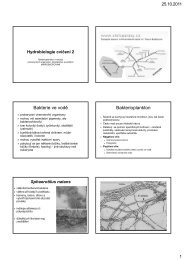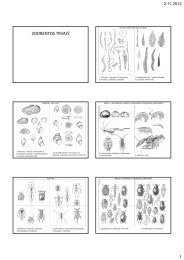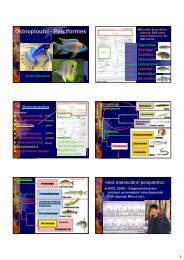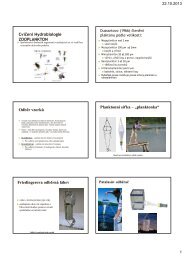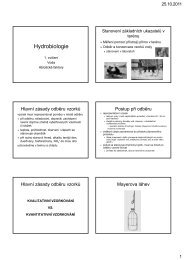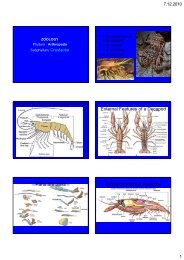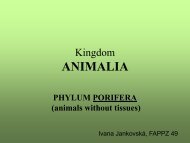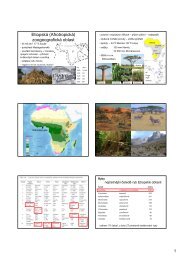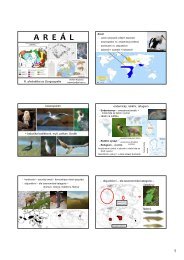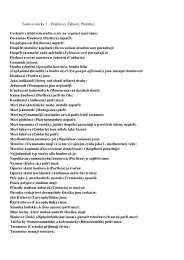You also want an ePaper? Increase the reach of your titles
YUMPU automatically turns print PDFs into web optimized ePapers that Google loves.
<strong>Phyllum</strong>:<br />
<strong>Mollusca</strong><br />
Mgr. Vladimír Vrabec, Ph.D.<br />
Dept. of Zoology and Fishery<br />
E-mail: vrabec@af.czu.cz<br />
<strong>Phyllum</strong>: <strong>Mollusca</strong><br />
Size: from 1 mm to 30 m, the number of species: up to 130 000<br />
Cutting the subphyllum by nature cover the body:<br />
1. Subphyllum: ACULIFERA<br />
Classis: Aplacophora<br />
Classis: Polyplacophora<br />
2. Subphyllum: CONCHIFERA<br />
Classis: Monoplacophora<br />
Classis: Gastropoda (Snails) based on location and type of respiratory:<br />
Subclassis: Prosobranchiata<br />
Ordo: Diotocardia<br />
Ordo: Monotocardia<br />
Subclassis: Opisthobranchiata<br />
Subclassis: Pulmonata<br />
Od Ordo: BBasommatophora t h<br />
Ordo: Stylommatophora<br />
(Alternative separation gastropods from the pleurovisceral connective, there is a transition in the case of separation by breathing. org.:<br />
tropical group Soleolifera<br />
Subclassis: Streptoneura = Prosobranchiata<br />
Subclassis: Euthyneura = Opisthobranchiata + Pulmonata)<br />
Classis: Scaphopoda<br />
Classis: Bivalvia (Shells)<br />
Ordo: Protobranchiata<br />
Ordo: Filibranchiata<br />
Ordo: Eulamellibranchiata<br />
Ordo: Septibranchiata<br />
Classis: Cephalopoda<br />
Subclassis: Tetrabranchiata<br />
Subclassis: Dibranchiata<br />
Ordo: Decabrachia<br />
Ordo: Octobrachia<br />
Beauty of Radulas<br />
Radula arises from specialized cells<br />
Serves<br />
the scaling of food<br />
Radula has<br />
specific<br />
characteristics<br />
Status of mollusc in the<br />
Zoological system<br />
COELOMATA<br />
A. Schizocoelia - coelom develops from teloblastic strip (base Blastomere 4d)<br />
if the single point > Type Oligomeric<br />
three phyllums: <strong>Mollusca</strong> (coelom occupies only a small part of the primary body cavity, the<br />
rest of it is mesenchyme )<br />
Sipunculida (coelom fills the whole body and is earmarked ring, which backs<br />
around the mouth, antennae here)<br />
Echiurida (coelom fills the whole body uniformly)<br />
if the embryo is based at least in terms of number of pair follicles > Polymer Type<br />
five phyllums: Annelida<br />
Onychophora<br />
Tardigrada<br />
Pentastomida (the old concept, now they are crustaceans )<br />
Arthropoda<br />
B. Enterocoelia – coelom is directly from the wall of the intestine<br />
Basic characteristics of <strong>Phyllum</strong><br />
• The body usually divided into head,<br />
foot and digestive gland<br />
• Create conchs<br />
• Body cavity is coelom type<br />
• Two types of muscle: retractors,<br />
adductors<br />
• Shell cavity<br />
The default type of the nervous system<br />
is amfineuric, concentration and move<br />
of ganglia to the head<br />
• Statocysts, osfradia<br />
• The through digestive system, radula,<br />
hepatopancreas, digestion of cellulose<br />
• Metanefridia<br />
• Open vascular system (1 to 4 cardiac<br />
hall)<br />
• Breathing through ktenidia, lung<br />
Reproduction<br />
• Native Gonochorism<br />
• External and internal fertilization<br />
• Asexual reproduction is not known<br />
• Hermaphroditism<br />
• Very rarely appears self-fertilization<br />
19.1.2010<br />
1
Developmental stages of<br />
molluscs<br />
• In the marine environment, the<br />
eggs hatch larvae: Trochofora<br />
type, Veliger type of snail and<br />
clam<br />
• In fresh water bivalve larvae as<br />
call glochidia<br />
Subphyllum: CONCHIFERA<br />
Characters: well-developed head, characterized by open conchs<br />
connected with the body<br />
Plžů Snails<br />
Shells<br />
Cephalopods p p<br />
Classis: Gastropoda (Snails)<br />
Characters: loss of bilateral and radial symmetry - a spiral winding of the shell, head with<br />
antennae, division based on location and type of respiratory, shell usually clockwise (! Exceptions),<br />
perhaps the secondary reduction, cerebral ganglion, pedal, pleural, parietal, visceral ganglia, during<br />
phylogenesis streptoneuric, eutyneuryc, osfradia, statocysts, eyes, radula, specialization of teeth,<br />
saliva with sulfuric acid, pericardial heart sac, 1-2 hallway, head and visceral arteries, with or<br />
without hemolymph mechanical function, kidneys; ktenidia breathing initially, then the blood<br />
circulation inside wall tires; gonochorists and hermaphrodites, unpaired gonads, duct behind the<br />
right tentacle, external and internal fertilization, very rarely self-fertilization, accessory glands,<br />
proteins, arrow bag, penis up to 10 x longer than the body, on direct the development of land, sea<br />
sometimes larvae (approximately 60% of marine species, 30% land, 10% of freshwater)<br />
Subphyllum: ACULIFERA<br />
Characters: low level of cephalisation, amfineuric<br />
Classis: Aplacophora<br />
Characters: body like worm, leg crease dull abdominal, primitive radula<br />
Species: Chaetoderma productum<br />
Classis: Polyplacophora<br />
Characters: ventrally visible head, on the surface of 8 plates, primitive shell cavity with a large number of ktenidia,<br />
metanefridie<br />
Species: Chiton olivaceus: 3 – 5 cm, perinotum (border), was able to furl in part, nocturnal animal, external fertilization,<br />
movement of sperm, larvae, tropical species are up to 30 cm<br />
Classis: Monoplacophora (older systems this classis sometimes excluded from Conchifera, while<br />
they should shell, but other nervous system)<br />
Characters: conch, 8 muscle indentation, circular foot, 5 pairs of ktenidia, amfineuric, 6 pairs of<br />
nefridia, 2 pairs of gonads, 2 pairs of inlet veins to the heart, coelom forms a cavity of the gonads<br />
and pericardium, long a fossil, as the Devonian (400 million years ago)<br />
Shortcut: Neopilina galatheae - discovered in the deep ditch in 1951-52 by the Danish expedition in<br />
the Pacific Ocean 300 nautical miles west of Mexico and Costa Rica, now known more recent<br />
species!<br />
Subclassis: Prosobranchiata<br />
Characters: ktenidia, the heart foyer, gonochorists, shell with a permanent lid (operculum)<br />
Ordo: Diotocardia<br />
Characters: Both cardiac vestibule present, 2 to 1 ktenidium, pearl shell layer<br />
Species: Vulgate Patella (limpet), Haliotis (abalone), Theodoxus danubialis<br />
19.1.2010<br />
2
Ordo: Monotocardia<br />
Characters: 1 heart hall, 1 ktenidium, 1 kidney and pedal ganglion<br />
Representatives: Cypraea - C. moneta as currency, Strombus gigas - decoy calls, Murex brandaris -<br />
color, Conus - fierce, poisonous, beautiful and precious as C. Milne-edwardsii about 300 USD, C.<br />
gloria-maris, about $ 2,000, etc., aristocratic collections - M. Teresa for Epithonium scalare 15 000<br />
tolars - pay may, in some Conus and 20 000 gold marks, etc., Vermetus, Entoconcha mirabilis -<br />
intestinal parasites in the blood vessels Sea Cucumbers, Ampularia gigas - aquarium, Viviparus –in<br />
Czech Republic, Bithynia – in the Czech republic<br />
19.1.2010<br />
3
Subclassis: Opisthobranchiata<br />
Characters: eutyneuryc, if the conch usually without lids, hermaphrodites, sea<br />
Species: Aplysia depilans, Clione limacina<br />
Classis: Scaphopoda<br />
Characters: box appearance hollow tusk, without eyes, triangular foot passing point without ktenidia,<br />
shell, radula, the transition between snails (common body structure, language tape) and bivalves<br />
(bilateral symmetry, engraving leg), in marine mud<br />
Shortcut: Dentalium vulgare - about 3.5 cm, some dentalia - exchange tender Indians<br />
Ordo: Protobranchiata<br />
Characters: ktenidia, the leg with the foot without byss gland<br />
and pericardium, gonads párovité in the leg, mostly marine, a few freshwater<br />
Ordo: Filibranchiata<br />
Characters: sedentary species with byss gland, hypertrophic back adductor mostly at the expense of the<br />
front and moved to the center of the body<br />
Representatives: Mytilus edulis (blue mussel) - Baltic, in Europe 100 000 t per year for food!, M.<br />
galloprovincialis - Mediterranean, allergies, mytilotoxin, synthetic production of mussels in the<br />
Netherlands - benches up to 60 000 t, Ostrea (oyster), Pecten (scallop), Pinctada margaritifera - up to<br />
30 cm, 9-10 kg, Japanese artificial pearls<br />
Subclassis: Pulmonata<br />
Characters: eutyneuryc, conch without a permanent lid (usually), hollow shell without<br />
gills, 3 ordo, from the Czech republic only 2:<br />
Ordo: Basommatophora<br />
Characters: eyes at the base of a single pair of antennae, usually water<br />
Representatives: Lymnaeidae - hosts of parasites (Galba truncatula), Planorbidae -<br />
bilharsiosis, Ancylidae, Physidae, Carychiidae, etc.<br />
Ordo: Stylommatophora<br />
Characters: eyes y on the upper pp end of retractile p pair of antennae, , land<br />
Representatives: Helicidae - Helix pomatia + H. aspersa - edible species, Clausilidae,<br />
Achatinidae - A fulica –pest, Vertigo - the smallest species, Arion - pest, breathing hole<br />
in the front, Limax - pest, breathing hole in the back, etc.<br />
Classis: Bivalvia<br />
Features: bilateral symmetry, the mantle consists of 2 lobes, shells, castle - ligament, 3 holes:<br />
acceptance, gutting and slide the foot (locomotion), sometimes reduction - byss fibers, missing head,<br />
radula and pharynx, microphaguous, mouth at the opposite end of the shell cavity than the opening<br />
reception, epithelium, adductors and retractors, cerebral ganglion, pleural blends, eyes on the edges of<br />
the shell or siphon (extended receiving tube emitted) osfradia, statocysts next pedal g. Innervated,<br />
cerebral, stomach, hepatopancreatic gland (2), intestine through the heart chamber, gills are ktenidia<br />
the original, derived from other types: filibranchia and lamelibranchia, heart 2 hall, the kidneys with a<br />
spout (Bojans) connected to pericardium, gonads in the leg, mostly marine, a few freshwater<br />
Production of shellfish in<br />
aquaculture<br />
• Annual production of<br />
molluscs in aquaculture is<br />
around 7 000 000 tons.<br />
A substantial part of the<br />
quantity of these are<br />
bivalves.<br />
• Of the approximately pp y 43%<br />
of oysters and mussels for<br />
about 16% (due to the<br />
price of oysters exhibit<br />
higher profitability)<br />
• Most common species in<br />
aquaculture is Crasostrea<br />
gigas, in Brazil, such as<br />
Perna perna - 90% of<br />
production<br />
19.1.2010<br />
4
LONGLINE<br />
SYSTEM<br />
Pinctada margaritifera and<br />
artificial pearls<br />
• Pearl fishery operated<br />
from ancient times - a<br />
dangerous profession<br />
• Kokiči Mikimoto -<br />
experiments with<br />
artificial cultivation of<br />
pearls since 1888, first<br />
success in 1893<br />
Artificial pearls<br />
• Catching live bivalves (now about 3 years old)<br />
• Incised muscle around the gonads, insertion or<br />
cut a piece of pearl shell donor<br />
• Deletion of infected bivalve molluscs to the<br />
original habitat in the basket, keeping about 2 to<br />
3 more years<br />
• Selecting "prepared" pearls, if the procedure<br />
survive, live for up to 15 years (repeat cycle)<br />
• Today is a closed cycle associated with pearl<br />
mussel larvae breeding in artificial containers,<br />
from where they are transferred back into the<br />
sea in the age of 1 year<br />
Ordo: Eulamellibranchiata<br />
Characters: freshwater only from this order, a large species of larvae - glochidia, small species are<br />
viviparous<br />
Shortcuts: sea: Cardium, Teredo navalis - reduction of shells, Tridacna, freshwater: Anodonta (Swan)<br />
- does not lock, Unio (mussel) - lock, Margaritana margaritifera (Freshwater pearl mussel), Pisidium,<br />
Sphaerium<br />
19.1.2010<br />
5
Ordo: Septibranchiata<br />
Characters: deep sea species, the gills as the septum, divides the mantle<br />
Shortcut: Cuspidaria - about 1.5 to 2.5 cm<br />
Classis: Cephalopoda<br />
Characters: head and torso, leg and arm changed in the funnel, sepia color, the concentration of<br />
ganglia in the head, eyes, convergence almost identical with the eyes the most advanced vertebrates,<br />
statocysts, olfactory pits, jaw, radula, salivary and poison glands, stomach, blind Pendant (coekum),<br />
paired hepatopancreas, rarely extracorporeal digestion, nearly closed vascular system (cerebral<br />
ganglia lacunae wheels and stomach), the number of heart hallway the same as ktenidia number,<br />
whether the number of kidney, gonochorists, hektocotylus, egg packaging with discoidal grooving,<br />
direct development, very large group of fossil<br />
19.1.2010<br />
6
Subclassis: Tetrabranchiata<br />
Characters: up to 90 arms, spiral coil conch<br />
Shortcut: Nautilus - about 25 cm, the Indian Ocean, conch (buoyancy chamber with N), fiber<br />
Sifo, living fossil<br />
Ordo: Octobrachia<br />
Characters: 8 identical arms<br />
Shortcuts: Octopus vulgaris (common octopus), Argonaut argo - secondary conch in female egg,<br />
arm effusion base, 3 left arm, the male mating - hektocotylus (Cuvier), female 30 cm, male 1 cm<br />
<strong>Phyllum</strong>: Echiurida<br />
Size: from 1 mm to 1 m, the number of species: up to 140<br />
Characters: sacculated prostomium and trunk, brain in trunk, the ventral side of the hull unpaired<br />
strand, closed vascular system, the function metanefridie, sex taps, gonochorists, dimorphism (male<br />
dwarf), cloaca, larva Trochophore type<br />
Shortcut: Bonelia viridis - males with no gastrointestinal tract, larvae homonomous, hormonal sex<br />
determination<br />
Subclassis: Dibranchiata<br />
Characters: 8-10 arms, reduction of conch<br />
Ordo: Decabrachia<br />
Characters: 8 short and 2 long arms, suction cups on the stems, Flipper hem on the sides of the hull,<br />
meals Italy polyps di Scoglio<br />
Representatives: Sepia officinalis (cuttlefish), Loligo (squid) - 0.5 m, a move to multiply into the<br />
North Sea, mating and egg at a depth of about 10 - 30 m, Architeutis dux - the largest invertebrate of<br />
planet, Flowers Cove (Florida): 21 m 95 cm, eye diameter 40 cm and 18 cm suction<br />
<strong>Phyllum</strong>: Sipunculida<br />
Size: from 1 to 60 cm, number of species: about 320<br />
Characters: elongate, trunk and introvert with a ring of wheels antenas, mouth cuticle (missing only in antenas), tree brain nerve cord,<br />
digestive tube longer than the body, metanefridia, extracorporeal fertilization, Trochofory type larvae, detritophagous,<br />
Shortcut: Sipunculus nudus - digging mud and sand, as land earthworms<br />
19.1.2010<br />
7


